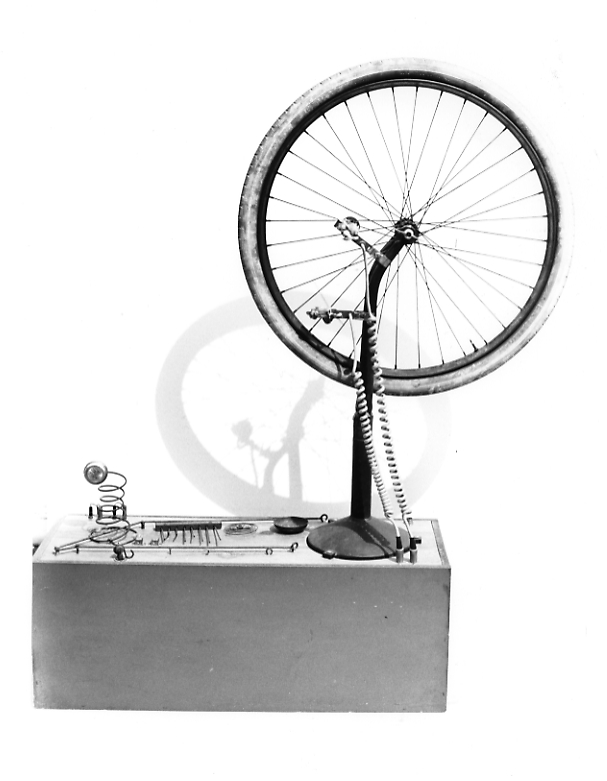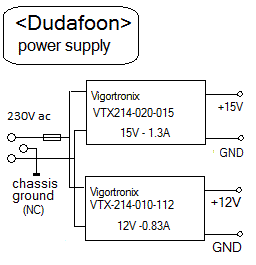'Dudafoon'
1974/75
An electroacoustic sculptural instrument
The name stems from: DUchamp, DAda and foon. The reference to Duchamp is because of the use of a bicycle wheel placed upside down, Dada is a reference to dadaism because of the conceptual simplicity of the instrument and the foon extension obviously refers to the fact that it is a musical instrument. The spokes of the bicycle wheel can be tuned. Exitation can be done by plucking or bowing. By changing the position of the wheel, different spokes and hence pitches can be selected. Object such as springs can be attached between the spokes. When the wheel is spun, very low frequencies are generated as the spokes pass in front of the electromagnetic spokes. An old bicycle wheel is mandatory here, as they always have steel spokes, unlike modern wheels equiped with aluminium spokes. Next to the wheel with its two pickups, the are two more electromagnetic pickups on the wooden upper plate. Large springs can be strung over these. In addition there also is a crystal contact microphone connected to the soundboard, thus amplifying the vibrations of any object attached to or placed on the soundboard.
The instrument was made shortly after our collaboration with Genesis P.Orridge and Paul Woodrow, with whom we performed a music theatrical piece using twelve Duchamp harps. Another influence was the work of Hugh Davies, who was a guest at Logos at that time. Other than in his instruments and object assemblies, we wanted to build one that could stand alone, so with built-in electronics and amplification.
 [picture by the author,
1974]
[picture by the author,
1974]
The instrument uses two power supply voltages: 12V and 15V. This was done to avoid motorboating as it plagued the first design using a single 12V supply or a lead battery. It uses very low impedance electromagnetic pick-ups taken from old telephones and has an internal mixer, a modified small Eagle 4-channel mixer using germanium transistors.
Biblio- and discography:
Godfried-Willem Raes 'My work as an instrument builder', Leonardo, 1993
Maintenance notes:
26.07.2015: As the original external power supply got lost, we decided to build a new unit and place it inside the instrument. So from now on there is an IEC power plug connector on the playing side of the instrument. Note that there no power switch. The instrument is switched on as soon as the power cord is connected to an outlet.
28.07.2015: Here is the extremely simple circuit for the new replacement power
supply:  After installing the new power supply, we noticed a lot of hiss as well as some
hum. The germanium transistors used in the original design were not perfect...
The S/R ratio would be unacceptable for a modern design. What to do? Improve
it with new circuitry or leave it in its historical state???
After installing the new power supply, we noticed a lot of hiss as well as some
hum. The germanium transistors used in the original design were not perfect...
The S/R ratio would be unacceptable for a modern design. What to do? Improve
it with new circuitry or leave it in its historical state???
29.07.2015: The potentiometers on the Eagle mixer appear to be worn out completely. Shouldn't we go for a modern design using opamps?
| Back to Logos Main Page: Logos Main Page |
| To homepage Godfried-Willem Raes |
Last updated: 2015-07-29